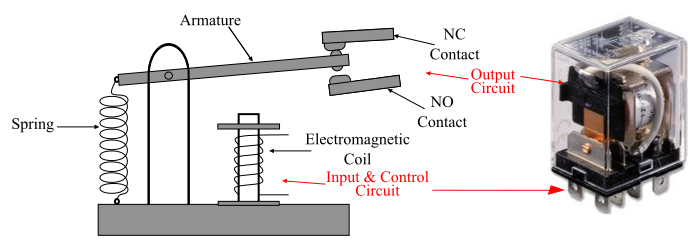
 Data Structure
Data Structure Networking
Networking RDBMS
RDBMS Operating System
Operating System Java
Java MS Excel
MS Excel iOS
iOS HTML
HTML CSS
CSS Android
Android Python
Python C Programming
C Programming C++
C++ C#
C# MongoDB
MongoDB MySQL
MySQL Javascript
Javascript PHP
PHP
- Selected Reading
- UPSC IAS Exams Notes
- Developer's Best Practices
- Questions and Answers
- Effective Resume Writing
- HR Interview Questions
- Computer Glossary
- Who is Who
Electromechanical Relays – Types and Working Principle
Electromechanical Relay
An electromechanical relay is a type of relay which function using a magnetic field produced by an electromagnetic coil when a control signal is applied to it. It is called as electromechanical since it has moving contacts in the output circuit which are operated by applying an electrical signal.
Electromechanical Relay: Working Principle
An electromechanical relay transfers signals between its contacts through a mechanical movement. It has three sections viz. input section, control section and output section.

The input section consists of input terminals where a small control signal is to be applied. The control section has an electromagnetic coil which gets energised when control input signal is applied to the input terminals and the output section consists of an movable armature and mechanical contacts – movable and stationary, the movement of the armature makes or breaks the electrical circuit.
When an input control voltage is applied to the electromagnetic coil, it gets magnetised and the armature is attracted by the magnetic field produced by the coil. The movable mechanical contacts are attached to the armature, thus when the armature moves towards the electromagnet, the contacts closes, making the output circuit switched on. When the control signal is removed, the armature comes back to its original position by the force of spring, making output circuit off.
Types of Electromechanical Relays
The electromechanical relays can be classified on the basis of their applications, construction & operation, and contact configuration etc.
Classification of EMRs based on their applications
General Purpose Relays – Such as miniature relays, latching relays, timer relays, contactors, machine tool relays, hybrid relays, smart relays, signal relays, automobile relays and PCB relays etc.
Protection Relays – Such as thermal overload relays, earth fault relays, under or over voltage relays, under or over current relays, buchholz relay, differential relays, distance protection relays, sequence protection relays, electronic relays etc.
Classification of EMRs based on contact configurations
Single-Pole Single-Throw (SPST)
Single-Pole Double-Throw (SPDT)
Double-Pole single-Throw (DPST)
Double-Pole Double-Throw (DPDT)

Classification of EMRs based on their construction & operation
Electromagnetic Attraction Type Relay – Such as attraction armature type EMR, solenoid type EMR, balanced beam type EMR.

Electromagnetic Induction Type Relay – Such as shaded pole type EMR, watt-hour meter type EMR, induction cup type EMR.


